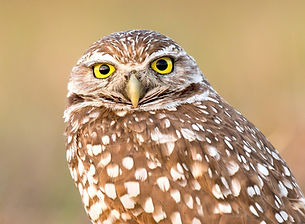NOTICE: This feature is a work-in-progress. If you encounter any issues, please e-mail us at info@BOWC.co.uk
Burrowing Owl
Athene cunicularia
//
19 - 28cm
51 - 61cm
140 - 240g
6 - 9 yrs
Size:
Weight:
Wingspan:
Lifespan:
The burrowing owl is a small owl found in grasslands and deserts across the Americas. True to their name, they live in burrows and - unlike most owls - become active during the day. They have developed long legs built for sprinting across open landscapes, although they can still fly when hunting.
Least Concern

LC

The head and upperparts are brown with white spotting, whilst the underparts are the opposite. They also have white eyebrow-like markings on the face as well as a band across chin, whereas the facial disc itself is rather squashed. Supposedly, the male plumage is lighter as they spend more time outside in the sun, thereby bleaching the feathers.
What Does it Look Like?
What Does it Sound Like?

Despite being capable of a wide variety of sounds, they are only somewhat vocal, with the two-note “cu-cuhooh” call of the male – which is often likened to a quail - being the most commonly heard. However, they are also capable of a harsh hissing designed to imitate the warning sound of a rattlesnake, which is generally used by the young to deter predators.

They chase prey down on their long legs. Termites appear to be a favourite, along with other invertebrates such as crickets, beetles, millipedes and spiders. It will also catch small rodents such as the vesper mouse and occasionally feeds on geckos, frogs or birds. Notably, they also eat the fruits of various cacti, which is unusual for an owl.
What Does it Eat?
Where Does it Nest?

They tend to reuse the burrows of prairie dogs, but can also dig their own. The nest is then lined with readily available material such as cattle dung, which also attracts insects to eat. A clutch of 4-12 eggs is laid and incubated for 4 weeks, and after a further 4 weeks the chicks are able to fly a short distance and eventually leave the nest.

They are known to breed in the southern tips of the US but are otherwise found broadly across Central and South America from Mexico through to Guatemala and then to Brazil, Patagonia and Tierra del Fuego. They prefer open, temperate grasslands, but also live in shrubland, savannah and semi-deserts, although they avoid venturing out in the midday heat.
Where Does it Live?
What is its Status?

Studies suggest their numbers are decreasing, but this reflects only the US figures, which are the minority. No official data exists for the South American population but, bizarrely, deforestation around the Amazon rainforest actually benefits burrowing owls due to the creation of open habitats. Similarly, they are also found increasingly on golf courses and at airports.
Image credit:
Disclaimer: Whilst we have worked to ensure the content on this page is accurate, any information included herein has been provided for entertainment purposes only and should not be used as a factual reference, including for conservational, biological, veterinary or other scientific uses, as it may not reflect the most up to date research or includes information that is unverified (or, where data is insufficient, has been based on assumptions of wild behaviors.) Species information has been compiled from a range of sources and the knowledge of the BOWC team. The use of content on this page without prior written permission from BOWC is strictly prohibited. Any photographs not owned by BOWC have been sourced under license with full credit given below the images used. Conservation status shown is as reported by the IUCN Red List. If you believe any of the information on this page is demonstrably inaccurate or has been used without proper accreditation, please e-mail info@BOWC.co.uk
